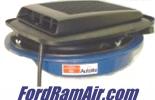|
Author
|
Topic: Turbocharged engines
|
Kyle
Gearhead Posts: 240
From: Sumner, WA
Registered: Dec 2001
|
 posted 09-25-2002 02:33 PM
posted 09-25-2002 02:33 PM
   
Do drag racing turbocharged engines need large cams, high flowing heads, and big headers like n/a race cars do? Or do they benefit from smaller ports and tubes for increased velocity? I have read that turbo cams need wide lobe sep. angles, and virtually no overlap, but what about lift and duration figures? At what boost levels do you need to begin thinking about o-ringing heads and running studs?
IP: Logged |
blown 351
Journeyman Posts: 64
From: Seattle, Wa. 98258
Registered: Dec 2001
|
 posted 09-25-2002 03:52 PM
posted 09-25-2002 03:52 PM
   
Pretty much the same as N/A engines.
They will benefit the same but with an increase in results.
The lobe separation angles which seem to work the best for the boosted applications I've worked with are 112-114 degrees. But the again, I don't spin the engines up past 6200 RPM.
Valve overlap can be reduced with boost, because the incoming pressure will scavenge the cylinder in nothing flat. Too much overlap, and they say you'll start blowing fuel/air mix down the headers.
Cam lift and durations, knock yourself out.
I have never found a need to approach it any different than N/A engines.
With the SBF I would be wanting to O-ring at anything above 9 or 10 PSI.
Head studs are a good idea anytime N/A or boosted, particularly with aluminum heads.
Your're just down the road in Sumner WA ?
Probably seen each other at Seattle Intl. raceway. Aqua 1968 fastback 393 stroker with procharger supercharger under the hood.
Say Hi if you see me.
IP: Logged |
Mike Harris
Gearhead Posts: 122
From: Oakfield, Ga USA
Registered: Jul 2002
|
 posted 09-25-2002 09:11 PM
posted 09-25-2002 09:11 PM
   
I'm right along the line of "Blown351"'s comments. Port work on the turbo combos is along the same lines as any other combo, you get the heads done, flow them, and then match the camshaft to those numbers along with other factors in the combo. LSA is critical in forced induction. With a wider LSA you get less overlap which is not needed in that application. You are not dependant on the "syphoning" effect of overlap like you would want in a NA motor because you are force feeding it. Too much overlap in forced induction combos tends to reduce cylinder pressure and volumetric efficiency. The less overlap you have, also results in less spent gasses in the new mix, which the benfit there is quite evident. In the overlap phase, you get the syphon effect, but some reversion will always be present. One thing I have noticed on turbo applications is that they tend to prefer a single pattern cam profile with a very agressive ramp rate particularly in the major intensity portion of the ramp. One caveat to the overlap issue (and there always are), maybe you are familiar with a Buick GN driven by Lawrence Conley called Tweaked. It hit the street scene back in the late 80's & early 90's with the Fastest Street Car Shootouts. He was running 8's back then and the cam in it had a 108 LSA!! Of course there was alot that went into it to make that work, but that is a story that he did not care to venture much into with alot of people. As far as o-ringing, 12-15psi is the most we have gotten away with before o-ringing, but I think 10psi would be a more logical "cut-off" point. We have gotten some good results with the o-ringed heads path, but they seem to give failures at 20psi and above. I would rather o-ring the block. As already said, a good, quality fastener is always a must. Anyway, hope this helps.------------------
Mike Harris
MKZ Racing
home.isoa.net/~mharrisj
IP: Logged |
TomP
Gearhead Posts: 4812
From: Delta BC Canada
Registered: Dec 99
|
 posted 09-26-2002 12:06 AM
posted 09-26-2002 12:06 AM
   
Turbo engines can use a fairly small and short tube header, the restriction doesn't hurt much. The fast turbo 5.0L (7.91@180)i've done some work on uses only a 1 3/4" tube now, down from the previous 2" tubes
IP: Logged | |











 Mustangsandmore Forums
Mustangsandmore Forums

 Ford Racing
Ford Racing

 Turbocharged engines
Turbocharged engines


